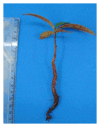Production of the quinone-methide triterpene maytenin by in vitro adventitious roots of Peritassa campestris (Cambess.) A.C.Sm. (Celastraceae) and rapid detection and identification by APCI-IT-MS/MS
- PMID: 24205504
- PMCID: PMC3800617
- DOI: 10.1155/2013/485837
Production of the quinone-methide triterpene maytenin by in vitro adventitious roots of Peritassa campestris (Cambess.) A.C.Sm. (Celastraceae) and rapid detection and identification by APCI-IT-MS/MS
Abstract
Establishment of adventitious root cultures of Peritassa campestris (Celastraceae) was achieved from seed cotyledons cultured in semisolid Woody Plant Medium (WPM) supplemented with 2% sucrose, 0.01% PVP, and 4.0 mg L⁻¹ IBA. Culture period on accumulation of biomass and quinone-methide triterpene maytenin in adventitious root were investigated. The accumulation of maytenin in these roots was compared with its accumulation in the roots of seedlings grown in a greenhouse (one year old). A rapid detection and identification of maytenin by direct injection into an atmospheric-pressure chemical ionization ion trap tandem mass spectrometer (APCI-IT-MS/MS) were performed without prior chromatographic separation. In vitro, the greatest accumulation of biomass occurred within 60 days of culture. The highest level of maytenin--972.11 μ g·g⁻¹ dry weight--was detected at seven days of cultivation; this value was 5.55-fold higher than that found in the roots of seedlings grown in a greenhouse.
Figures






Similar articles
-
Mevalonate-derived quinonemethide triterpenoid from in vitro roots of Peritassa laevigata and their localization in root tissue by MALDI imaging.Sci Rep. 2016 Mar 4;6:22627. doi: 10.1038/srep22627. Sci Rep. 2016. PMID: 26943243 Free PMC article.
-
Anticancer Activities of the Quinone-Methide Triterpenes Maytenin and 22-β-hydroxymaytenin Obtained from Cultivated Maytenus ilicifolia Roots Associated with Down-Regulation of miRNA-27a and miR-20a/miR-17-5p.Molecules. 2020 Feb 10;25(3):760. doi: 10.3390/molecules25030760. Molecules. 2020. PMID: 32050628 Free PMC article.
-
Maytenin Plays a Special Role in the Regulation of the Endophytic Bacillus megaterium in Peritassa campestris Adventitious Roots.J Chem Ecol. 2019 Sep;45(9):789-797. doi: 10.1007/s10886-019-01096-y. Epub 2019 Aug 17. J Chem Ecol. 2019. PMID: 31422514
-
Ecological Insights to Track Cytotoxic Compounds among Maytenus ilicifolia Living Individuals and Clones of an Ex Situ Collection.Molecules. 2019 Mar 23;24(6):1160. doi: 10.3390/molecules24061160. Molecules. 2019. PMID: 30909567 Free PMC article.
-
Production of biomass and bioactive compounds from adventitious roots by optimization of culturing conditions of Eurycoma longifolia in balloon-type bubble bioreactor system.J Biosci Bioeng. 2015 Jun;119(6):712-7. doi: 10.1016/j.jbiosc.2014.11.010. Epub 2014 Dec 12. J Biosci Bioeng. 2015. PMID: 25511788
Cited by
-
Mevalonate-derived quinonemethide triterpenoid from in vitro roots of Peritassa laevigata and their localization in root tissue by MALDI imaging.Sci Rep. 2016 Mar 4;6:22627. doi: 10.1038/srep22627. Sci Rep. 2016. PMID: 26943243 Free PMC article.
-
Anticancer Activities of the Quinone-Methide Triterpenes Maytenin and 22-β-hydroxymaytenin Obtained from Cultivated Maytenus ilicifolia Roots Associated with Down-Regulation of miRNA-27a and miR-20a/miR-17-5p.Molecules. 2020 Feb 10;25(3):760. doi: 10.3390/molecules25030760. Molecules. 2020. PMID: 32050628 Free PMC article.
-
Comprehensive mass spectrometric metabolomic profiling of a chemically diverse collection of plants of the Celastraceae family.Sci Data. 2024 Apr 22;11(1):415. doi: 10.1038/s41597-024-03094-6. Sci Data. 2024. PMID: 38649352 Free PMC article.
-
Maytenin Plays a Special Role in the Regulation of the Endophytic Bacillus megaterium in Peritassa campestris Adventitious Roots.J Chem Ecol. 2019 Sep;45(9):789-797. doi: 10.1007/s10886-019-01096-y. Epub 2019 Aug 17. J Chem Ecol. 2019. PMID: 31422514
-
Beneficial effect of pristimerin against the development of osteoporosis in ovariectomy-induced osteoporosis rats by the RANKL/TRAF6/NF-κB pathway.Arch Med Sci. 2019 Jul 22;18(6):1650-1658. doi: 10.5114/aoms.2019.86816. eCollection 2022. Arch Med Sci. 2019. PMID: 36457960 Free PMC article.
References
-
- Buffa-Filho WB, Corsino J, Bolzani VS, Furlan M, Pereira AMS, França SC. Quantitative determination of cytotoxic Friedo-nor-oleanane derivatives from five morphological types of Maytenus ilicifolia (Celastraceae) by reverse-phase high-performance liquid chromatography. Phytochemical Analysis. 2002;13(2):75–78. - PubMed
-
- Corsino J, de Carvalho PRF, Kato MJ, et al. Biosynthesis of friedelane and quinonemethide triterpenoids is compartmentalized in Maytenus aquifolium and Salacia campestris . Phytochemistry. 2000;55(7):741–748. - PubMed
-
- Kim DH, Shin EK, Kim YH, et al. Suppression of inflammatory responses by celastrol, a quinone methide triterpenoid isolated from Celastrus regelii . European Journal of Clinical Investigation. 2009;39(9):819–827. - PubMed
-
- Jeller AH, Silva DHS, Liao LM, Bolzani VS, Furlan M. Antioxidant phenolic and quinonemethide triterpenes from Cheiloclinium cognatum . Phytochemistry. 2004;65(13):1977–1982. - PubMed
Publication types
MeSH terms
Substances
LinkOut - more resources
Full Text Sources
Other Literature Sources
Research Materials

